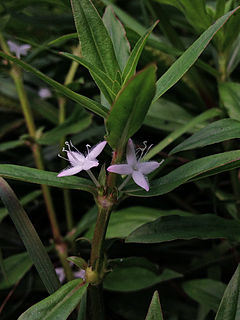
Diodia is a genus of flowering plants in the family Rubiaceae. It was described by Carl Linnaeus in 1753. The genus is found from southern and eastern United States, South America, Central America, Mexico, the West Indies and tropical Africa.
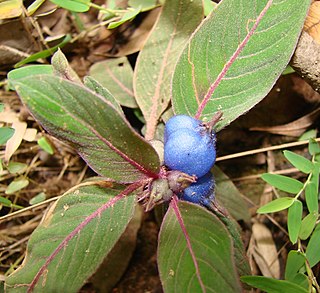
Coccocypselum is a genus of flowering plants in the family Rubiaceae. It is native to Mexico, Central America, the West Indies and South America. All species of the genus Coccocypselum are herbaceous with fleshy, blue or purple fruits, and 4-petaled flowers.

Sideroxylon is a genus of trees in the family Sapotaceae described as a genus by Linnaeus in 1753. They are collectively known as bully trees. The generic name is derived from the Greek words σιδηρος (sideros), meaning "iron", and ξύλον (xylon), meaning "wood."
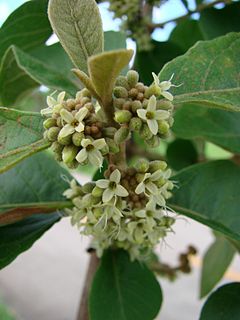
Aegiphila is a genus of flowering plants in the mint family, Lamiaceae, first described in 1763. It was formerly classified in the Verbenaceae. It is native to Mexico, Central America, South America, the West Indies, and Florida.

Casasia is a genus of flowering plants in the family Rubiaceae. These shrubs or small trees occur on the Caribbean islands and in one case in Florida. Some of the ten accepted species were formerly placed elsewhere, e.g. in the related genip-tree genus (Genipa), in Gardenia or in Randia.

Exostema is a genus of flowering plants in the family Rubiaceae. It consists of trees and shrubs, endemic to the neotropics, with most of the species occurring in the West Indies.

Citharexylum is a genus of flowering plants in the verbena family, Verbenaceae. It contains shrub and tree species commonly known as fiddlewoods or zitherwoods. They are native to the Americas, ranging from southern Florida and Texas in the United States to Argentina. The highest diversity occurs in Mexico and the Andes. The generic name is derived from the Greek words κιθάρα (kithara), meaning "lyre", and ξύλον (xylon), meaning "wood," referring to the use of the wood in the sounding boards of string instruments. Several species, especially C. caudatum and C. spinosum, are cultivated as ornamentals.
- Citharexylum affineD.Don - from northern Mexico to Nicaragua
- Citharexylum alainiiMoldenke - Dominican Republic
- Citharexylum albicauleTurcz. - Cuba
- Citharexylum altamiranumGreenm. - northeastern Mexico
- Citharexylum andinumMoldenke - Bolivia, Jujuy Province of Argentina
- Citharexylum argutedentatumMoldenke - Peru
- Citharexylum berlandieriB.L. Rob. - from Texas to Oaxaca - Berlandier's fiddlewood, Tamaulipan fiddlewood
- Citharexylum bourgeauanumGreenm. - Veracruz, Oaxaca
- Citharexylum brachyanthum(A.Gray ex Hemsl.) A.Gray - Texas, Coahuila, Nuevo León - Boxthorn fiddlewood, Mexican fiddlewood
- Citharexylum bullatumMoldenke - Colombia
- Citharexylum calvumMoldenke - Quintana Roo
- Citharexylum caudatumL. - southern Mexico, West Indies, Central America, Colombia, Peru - Juniper berry
- Citharexylum chartaceumMoldenke - Peru, Ecuador
- Citharexylum cooperiStandl. - Costa Rica, Panama, Guatemala
- Citharexylum costaricenseMoldenke - Costa Rica, Nicaragua, Honduras
- Citharexylum crassifoliumGreenm - Chiapas, Belize, Guatemala, Honduras
- Citharexylum daniraeLeón de la Luz & F.Chiang - Revillagigedo Islands of Baja California
- Citharexylum decorumMoldenke - Colombia, Venezuela
- Citharexylum dentatumD.Don - Peru
- Citharexylum discolorTurcz. - Cuba, Hispaniola
- Citharexylum donnell-smithiiGreenm. - Oaxaca, Chiapas, Central America
- Citharexylum dryanderaeMoldenke - Colombia, Venezuela, Peru, Ecuador
- Citharexylum ekmaniiMoldenke - Cuba
- Citharexylum ellipticumMoc. & Sessé ex D.Don - Veracruz, Campeche, Tabasco; naturalized in Cuba + Cayman Islands
- Citharexylum endlichiiMoldenke - northeastern Mexico
- Citharexylum flabellifoliumS.Watson - Sonora, Baja California
- Citharexylum flexuosum(Ruiz & Pav.) D.Don - Bolivia, Peru
- Citharexylum fulgidumMoldenke - Veracruz, northeastern Mexico
- Citharexylum gentryiMoldenke - Ecuador
- Citharexylum glabrum(S.Watson) Greenm - Oaxaca
- Citharexylum glazioviiMoldenke - eastern Brazil
- Citharexylum grandiflorumAymard & Rueda - Ecuador
- Citharexylum guatemalense(Moldenke) D.N.Gibson - Guatemala, Nicaragua
- Citharexylum herreraeMansf. - Peru
- Citharexylum hexangulareGreenm. - from northern Mexico to Costa Rica
- Citharexylum hidalgenseMoldenke - Mexico
- Citharexylum hintoniiMoldenke - México State
- Citharexylum hirtellumStandl. - from Veracruz to Panama
- Citharexylum ilicifoliumKunth - Bolivia, Peru, Ecuador
- Citharexylum iltisiiMoldenke - Peru
- Citharexylum × jamaicenseMoldenke - Jamaica, Haiti, Puerto Rico (C. caudatum × C. spinosum)
- Citharexylum joergensenii(Lillo) Moldenke - Argentina, Bolivia
- Citharexylum karsteniiMoldenke - Colombia, Venezuela
- Citharexylum kerberiGreenm. - Veracruz
- Citharexylum kobuskianumMoldenke - Peru
- Citharexylum krukoviiMoldenke - eastern Brazil
- Citharexylum kunthianumMoldenke - Colombia, Venezuela, Ecuador
- Citharexylum laetumHiern - southern Brazil
- Citharexylum laurifoliumHayek - Bolivia, Peru
- Citharexylum lemsiiMoldenke - Guanacaste Province in Costa Rica
- Citharexylum × leonisMoldenke - Cuba (C. caudatum × C. tristachyum)
- Citharexylum ligustrifolium(Thur. ex Decne.) Van Houtte - Mexico
- Citharexylum lojenseMoldenke - Ecuador
- Citharexylum lucidumCham. & Schltdl. - Mexico
- Citharexylum lycioidesD.Don - Mexico
- Citharexylum macradeniumGreenm. - Panama, Costa Rica
- Citharexylum macrochlamysPittier - Panama, Colombia
- Citharexylum macrophyllumPoir. - Colombia, Venezuela, Ecuador, Guianas, northwestern Brazil
- Citharexylum matheanumBorhidi & Kereszty - Cuba
- Citharexylum matudaeMoldenke - Chiapas
- Citharexylum mexicanumMoldenke - Veracruz, Puebla, Oaxaca
- Citharexylum microphyllum(DC.) O.E.Schulz - Hisipaniola
- Citharexylum mirifoliumMoldenke - Colombia, Venezuela
- Citharexylum mocinoiD.Don - Mexico, Central America
- Citharexylum montanumMoldenke - Colombia, Ecuador
- Citharexylum montevidense(Spreng.) Moldenke - Brazil, Argentina, Paraguay, Uruguay
- Citharexylum myrianthumCham. - Brazil, Argentina, Paraguay
- Citharexylum obtusifoliumKuhlm - Espírito Santo
- Citharexylum oleinum Moldenke - Mexico
- Citharexylum ovatifoliumGreenm. - Mexico
- Citharexylum pachyphyllumMoldenke - Peru
- Citharexylum pernambucenseMoldenke - eastern Brazil
- Citharexylum poeppigiiWalp. - Colombia, Venezuela, Ecuador, Bolivia, Peru, Brazil
- Citharexylum punctatumGreenm. - Bolivia, Peru
- Citharexylum quercifoliumHayek - Peru
- Citharexylum quitenseSpreng. - Ecuador
- Citharexylum racemosumSessé & Moc. - Mexico
- Citharexylum reticulatumKunth - Ecuador, Peru
- Citharexylum rigidum(Briq.) Moldenke - Paraguay, southern Brazil
- Citharexylum rimbachiiMoldenke - Ecuador
- Citharexylum roseiGreenm. - Mexico
- Citharexylum roxanaeMoldenke - Baja California
- Citharexylum scabrumMoc. & Sessé ex D.Don - northern Mexico
- Citharexylum schottiiGreenm. - southern Mexico, Central America
- Citharexylum schulziiUrb. & Ekman - Hispaniola
- Citharexylum sessaeiD.Don - Mexico
- Citharexylum shreveiMoldenke - Sonora
- Citharexylum solanaceumCham. - southern Brazil
- Citharexylum spinosumL. – Spiny fiddlewood - West Indies, Panama, Venezuela, the Guianas; naturalized in India, Mozambique, Fiji, Bermuda
- Citharexylum stenophyllumUrb. & Ekman - Haiti
- Citharexylum steyermarkiiMoldenke - Veracruz, Chiapas, Guatemala
- Citharexylum suberosumLoes. ex Moldenke - Cuba
- Citharexylum subflavescensS.F.Blake - Colombia, Venezuela, Ecuador, Peru
- Citharexylum subthyrsoideumPittier - Colombia, Venezuela
- Citharexylum subtruncatumMoldenke - northwestern Brazil
- Citharexylum sulcatumMoldenke - Colombia
- Citharexylum svensoniiMoldenke - Ecuador
- Citharexylum teclenseStandl. - El Salvador
- Citharexylum ternatumMoldenke - Cuba
- Citharexylum tetramerumBrandegee - Valle de Tehuacán-Cuicatlán in Mexico
- Citharexylum tristachyumTurcz. – Threespike Fiddlewood - Cuba, Jamaica, Leeward Islands
- Citharexylum uleiMoldenke - Colombia, Peru, northwestern Brazil
- Citharexylum vallenseMoldenke - Colombia
- Citharexylum venezuelenseMoldenke - Venezuela
- Citharexylum weberbaueriHayek - Peru
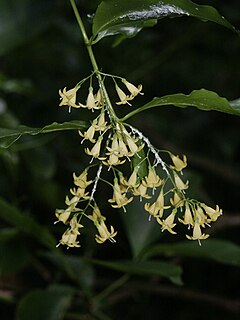
Chiococca is a genus of flowering plants in the family Rubiaceae. It currently holds 23 species that are native to Florida, Texas, Mexico, Central America, much of South America, the West Indies, and the Galápagos.

Portlandia is a genus of flowering plants in the coffee family, Rubiaceae. Members of the genus are endemic to Jamaica.
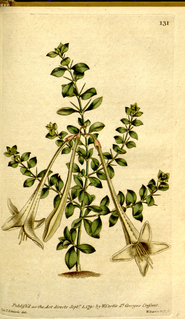
Catesbaea is a genus of flowering plants in the family Rubiaceae. It occurs in the West Indies, The Bahamas, and the Florida Keys. The genus is named in honour of English naturalist Mark Catesby.
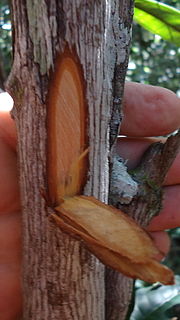
Amaioua is a genus of flowering plants in the family Rubiaceae. It was first described by Jean Baptiste Aublet in 1775. The genus is native to tropical America from southern Mexico to Brazil, including Cuba and Trinidad.

Rondeletieae is a tribe of flowering plants in the family Rubiaceae and contains about 178 species in 8 genera. Its representatives are found from southern Mexico to northern South America and in the Caribbean.

Chomelia is a genus of flowering plants in the family Rubiaceae. It is native to Mexico, Central America, the West Indies, and much of South America as far south as Argentina.
Mazaea is a genus of flowering plants in the family Rubiaceae. It is endemic to Cuba.

Margaritopsis is a genus of flowering plants in the coffee family. The genus is found from Mexico to tropical America.

Chimarrhis is a genus of flowering plants in the family Rubiaceae. It has 15 recognized species, native to Central America, South America and the West Indies.
Coutaportla is a genus of flowering plants in the family Rubiaceae. It is found in Mexico and Guatemala.

Condamineeae is a tribe of flowering plants in the family Rubiaceae and contains about 305 species in 31 genera. Most genera are found in Central and Southern Tropical America, but a few occur in Southeast Asia.
Vallesia is a genus of plants in the family Apocynaceae first described as a genus in 1794. It is native to South America, Central America, Mexico, Florida, Galápagos, and the West Indies.
Schmidtottia is a genus of flowering plants in the family Rubiaceae, native to eastern Cuba. Adapted to serpentine soils, they are nickel hyperaccumulators.
This page is based on this
Wikipedia article Text is available under the
CC BY-SA 4.0 license; additional terms may apply.
Images, videos and audio are available under their respective licenses.















